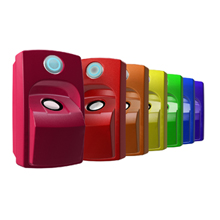 |
| At the event, iEvo will demonstrate how users can create personalised biometric access control units to suit their specific needs |
At the 2014 IFSEC International Exposition to be held 17-19 June at the ExCeL in London, attendees will see how they can create personalised biometric access control units that suit their specific needs without altering the look or design of the fingerprint readers themselves. At Booth A1755, iEvo will feature newly designed custom kits that let users incorporate a host of options including card readers, increased template capacity and Power over Ethernet (PoE) while also providing Lumidigm multispectral fingerprint sensors that assure a reliable read the first time.
"We are continually trying to push the boundaries within the security market and provide users with the most up to date advancements," reports Shaun Oakes, Managing Director of iEvo. "From our customer feedback, we found that users wanted more flexibility and freedom to create a biometric access control system to suit their project and installation needs. Through our custom kit additions, users will be able to create their very own ievo system that is fully customisable and fully field serviceable while integrators will open new markets to win new business."
The new custom kit will provide ievo customers with highly reliable and flexible readers. Besides leveraging the unmatched performance of multispectral fingerprint sensors, customers can highly tailor their own readers. For instance, if there is already a card reader at the site, customers can replace the card reader with options that let the biometric readers use most pre-existing cards. They can also provide a biometric template on the card, reducing their reliance on a central database. For users wanting to use identification mode (1:N search), ievo offers a standard capacity of up to 10,000 fingerprint templates and can be expanded to 50,000 templates.
By using PoE to power the control board, reader installation becomes faster, easier and more cost-effective. Wireless or Bluetooth communication can be used instead of a LAN. Now, one control board can handle both an ingress and egress reader reducing overall hardware and installation costs. The unit can be fitted with a Two Line Screen, perfect for time and attendance applications in which users want to see the date and time they scan in and out. Lastly, the readers are available in custom colours.
Most importantly, all this flexibility comes in tandem with the multispectral fingerprint sensors that use a sophisticated technology specifically developed by Lumidigm to overcome the fingerprint capture problems found with conventional imaging systems. This more-effective technology is based on the use of multiple spectrums of light and advanced optical techniques to extract unique fingerprint characteristics from both the surface and subsurface of the skin. That subsurface capability is important because the fingerprint ridges seen on the surface of the finger have their foundation beneath the surface of the skin, in the capillary beds and other sub-dermal structures.
Discover how AI, biometrics, and analytics are transforming casino security























